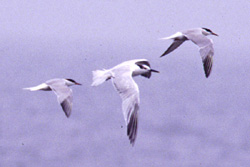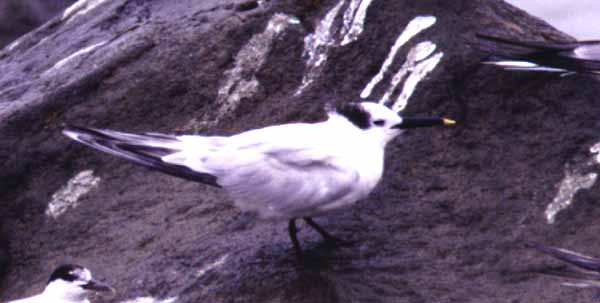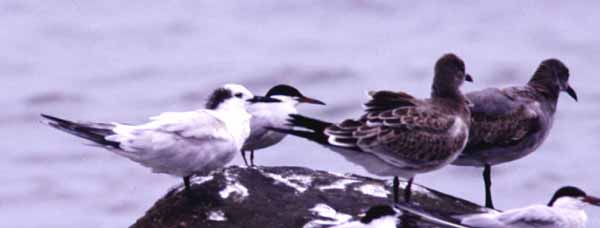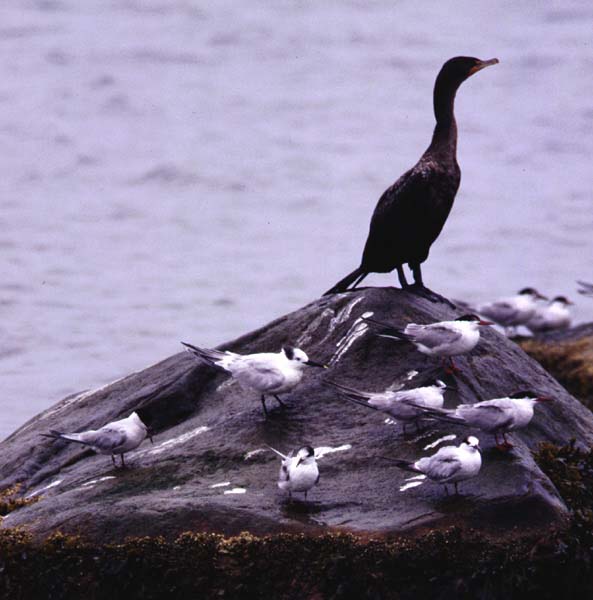|
Despite foggy conditions we were enjoying scanning
a large and very dynamic feeding flock of terns and gull a few
hundred yards off Montauk Point, when Tony Lauro drew everyone's
attention to a largish white tern leaving the flock and heading
west along the beach. Tony was quick enough to see the bill which
appeared to be dark, and this was confirmed by Andy Guthrie and
Paul Buckley. All of us felt certain, based on the bill and the
relative size compared to the Common (S. hirundo) and Forster's
Terns (S. fosteri) (as well as the Royal Terns (S. maxima)
that we had seen earlier in the morning), that we were looking
at a Sandwich Tern (S. sandvicensis).
We relocated the Sandwich Tern farther along the beach, roosting
on some small partially submerged rocks along with a flock of 30-50
Common Terns and at least 2 Roseate Terns (S. dougallii).
We were able to approach within 50 yards and photograph the bird
(see figures below), which appeared to be a subadult Sandwich Tern
(S. sandvicensis) probably in its 2nd calander year (see
below).
|

Figure 1. In
flight. Notice the dark outer primaries, dark greater coverts
and incomplete secondary bar. The newer inner primaries
are white. The outertail feathers are relatively short.
(Image Copyright © of Angus Wilson)
|

Figure 2. Close-up
view showing long black bill with yellow tip. The feathering across
the forehead and crown are white. (Image Copyright © of Angus
Wilson)
|

Figure 3. Perched
on the crest of a boulder with Common Terns.
(Image Copyright © of Angus Wilson)
|
|

Figure 4.
Perched on a boulder with Common Terns and a Double-crested
Cormorant.
(Image Copyright © of Angus Wilson)
|
|

Figure 5. Landing
on a boulder amid Laughing Gulls and Common Terns.
(Image Copyright © of Angus Wilson)
|
|

Figure 6. Falling
asleep! (Image Copyright © of Angus Wilson)
|
Identification:
Given the prolonged close views and detailed photographs, the identification
was straight forward. The key features included:
(1) Size - significantly larger than accompanying Common Terns,
although not as large or as long-legged as Laughing Gulls (Larus
atricilla).
(2) Bill shape and color - Long, slightly down-curved dark bill
complete with yellow tip.
(3) Head pattern - Long and angular head with a flat crown. White
forehead and central part of crown with dark remnants of cap restricted
to the nape.
(4) Primary pattern - Dark outer primaries (due to wear?).
(5) Aging - The presence of a dark subterimal bar across the central
secondaries, and the minimal tail fork both suggest the bird might
be a subadult in its second summer (Olsen and Larsson, 1995).
Literature:
Olsen, K. M. and Larsson, H. (1995) Terns of Europe and North America.
Princeton University Press.
Return
to Gallery Index
|

